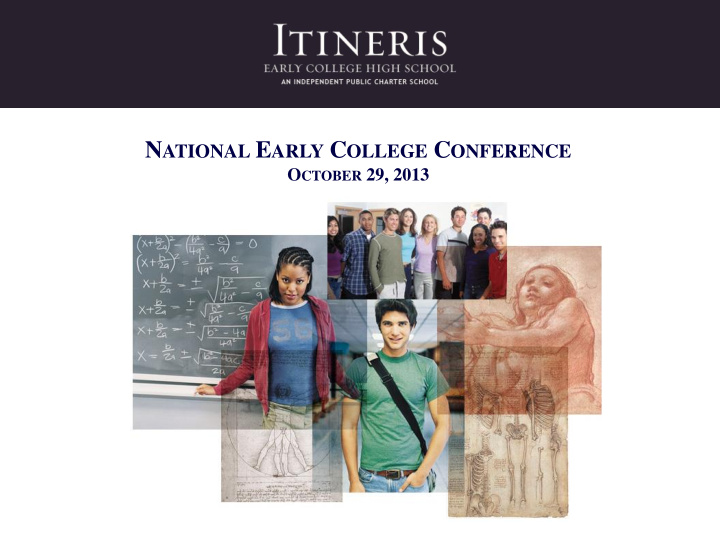



N ATIONAL E ARLY C OLLEGE C ONFERENCE O CTOBER 29, 2013
E ARLY C OLLEGE B EGINNINGS IN U TAH • Academy of Math Engineering & Science (AMES) 2003/University of Utah • Itineris Early College High School 2004/Salt Lake Community College • Northern Utah Academy of Math Engineering & Science (NUAMES) 2004/Weber State University • Utah County Academy of Sciences (UCAS) 2005/Utah Valley University • Success Academy 2006/Southern Utah University & Dixie State College • InTech Collegiate High School 2007/Utah State University
• Each school has a math & science academic mission. • All schools, except one, are located on or near a college campus. • All schools, except one, use 10-12 grade configuration. • All schools, except one, have primarily an engineering/physics focus with the exception being biotechnology.
C REATING C OLLEGE G OING C ULTURE CONNECT TIME ( Student Advisory) At Itineris Early College High School, every student is enrolled in a structured course designed to develop the skills necessary for college or career readiness. The class will consist of a group of students of the same grade, called a cohort. Each cohort will have one faculty member that will facilitate the curriculum. The cohort and faculty member will remain the same for the three years a student is enrolled at Itineris.
CONNECT TIME CURRICULUM ( Research Based) • Literacy • Academic Advising • Numeracy • Time Management • Memory • Personal Educational Planning • Test Taking Strategies • Career Information • Health & Nutrition • Study Skill Development • Learning Styles • Cooperative Learning Projects • Critical Thinking • Service Projects • Academic Honesty • Communication Skills • Diversity • Collective Decision Making • Money • Academic Vocabulary
• College Calendar • No Bells • College Class Schedule (M,W,F) • College Student ID’s • Classroom Management System (Blackboard, Canvas, etc.) • Grading Practices • Teacher Evaluations • No Assemblies
Lo Loca cati tion on of of co cour urses ses by enr y enrol ollme ment nt 5% 5% 18 18% Secondary Postsecondary Distance 77%
Im Impor ortance tance of of Sta tand ndar ards ds an and Q d Qua ualit ity Not all colleges accept dual-credit hours amassed by Texas high school students NYU Downgrades Dual Enrollment Report Shows Dual Enrollment Best When on College Campus Council of Writing Program Administrators WPA- L Listserv topic: “Credit Laundering”
NACEP EP Sta tand ndar ards ds: : Gu Guid idin ing Pr Prin inci ciples es A high quality concurrent enrollment program (CEP) is one where: College courses offered in high schools are as rigor gorous us as courses offered on the sponsoring college campus CEP EP students dents are held to the same expectations and standards of achievement as on campus students CEP EP ins nstr truct uctor ors s meet the same requirements for on campus adjunct instructors, and are provided support by faculty in their discipline CEP EP program gram oversight sight is sufficient to ensure the academic integrity of its courses, regardless of where they are taught and by whom
Fac acul ulty ty Col olla laboration boration is is Cr Crit itic ical al Instructors must be approved by the academic emic depar artme tment nt Instructors must receive course se-spe specif cific ic orien entat tation n prior to teaching the course Ongoing ann nnual, ual, discipline cipline-spec specif ific ic professional development Mechanisms for alignment of curric riculu ulum, m, assessm sessmen ents, ts, and nd grading ding scales es Faculty lty site e visits its to ensure that the college course taught in the high school is the same as the course offered on campus
Con onsi sist stent ent Ex Expec ecta tati tions ons Students meet the same academic emic crit iteria eria to enroll oll in course (placement testing, course prerequisites) Courses must include same course conten ent, t, learning rning outcom omes, es, and grading ding scales es Students must be assessed sessed using consistent methods Course registration gistration and transc anscriptin ripting is consistent with on campus procedures
Di Disp splaying ying Gr Grea eater er Acc ccou ountabi ntabili lity ty Because of the added scrutiny that concurrent enrollment faces, programs can display greater accountability by: Conducting end of course se student dent evaluation ations for every CEP course section each term, regardless of the frequency of on-campus evaluations Preparing program ram evaluatio ations ns through surveys of participating instructors, guidance counselors, and principals Rese sear arch h long ngitu itudinal inal student udent suc uccess ess, including student alumni surveys
Recommend
More recommend